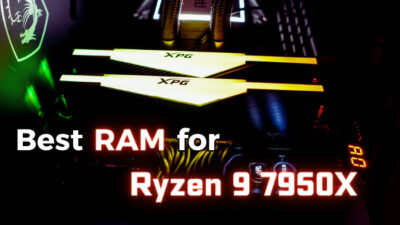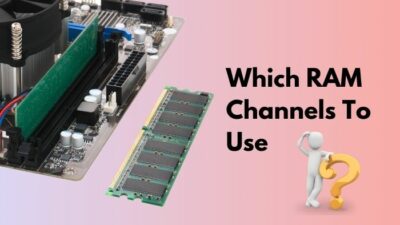While choosing components for new PC builds, PC enthusiasts and gamers always prefer to pick the fastest available ones. However, the situation is slightly different for RAM than other PC parts. You must consider several factors before selecting the best RAM kit for your new rig.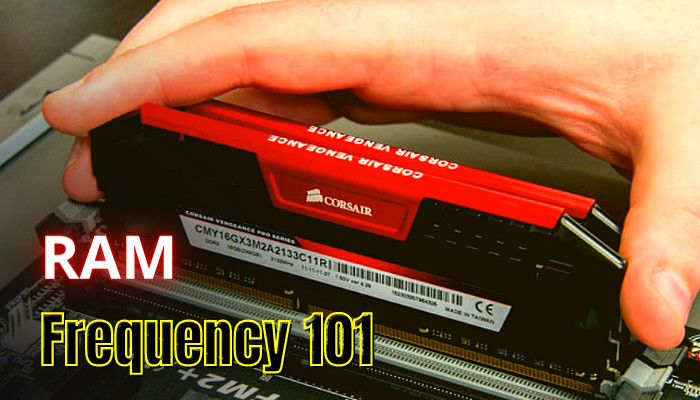
In this article, I will cover all the ins and outs of memory frequency and the procedure of choosing the best RAM.
So, let’s get started!
What Does the RAM Frequency Mean? The Basics of RAM Speed
RAM speed (also known as memory frequency) is the number of instructions a RAM can process per second. In other words, it is the data transfer rate that the RAM can pass to and from the CPU every second.
The MHz acronym is megahertz, which can perform a million cycles per second. This measurement unit is used to compute the speed of data moving within and between computer components. While SDRAM (Synchronous Dynamic Random Access Memory) was introduced in the early ’90s, manufacturers added the transfer rate in MHz after the RAM name to indicate speed.
A few years later from that event, people were introduced to a new technology, DDR (Double Data Rate). It was a vast improvement in terms of performance because it doubled the data transfers per clock cycle of the previous DRAM.
For instance, a 1000 MHz DRAM can perform 1000 x 10^6 (one billion) data transfers per clock cycle. Contrarily, a DDR RAM can process 2000 x 10^6 (two billion) data transfers per clock cycle with the same specs.
Though the performance doubled with the new DDR technology, the measurement unit did not change. And manufacturers are still keeping MHz in the new RAMs name.
The striking feature of DDR RAM allows it to transfer two signals per clock cycle. Moreover, DDR RAM can use a multicore CPU by accessing it with multiple channels.
Now let me clarify a few terms; MHz is the clock cycle representing how many cycles can be executed per second. On the other hand, MT/s (megatransfers or million transfers) is the measurement of the data speed (transfer rate) of DDR and SDRAM memory.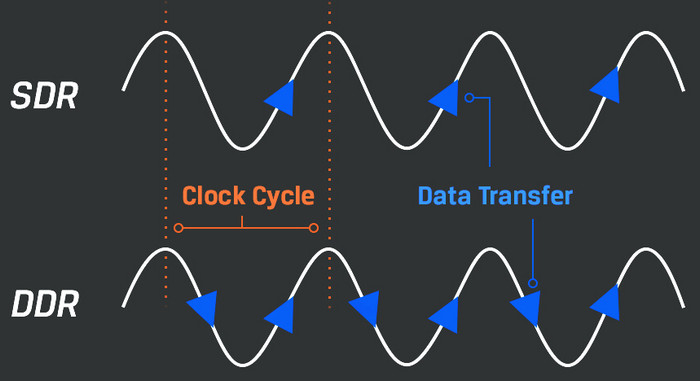
To better understand the differences between megahertz and megatransfers, check out our separate post on MHz vs. MT/s. We’ve covered this in a beginner friendly way.
In my opinion, naming the DDR RAMs with MT/s is more relevant than naming them with MHz. Consider the following table to understand more.
| Parameters | SDRAM | DDR SDRAM |
|---|---|---|
| Clock | 1000 MHz | 1000 MHz |
| Transfer Rate | 1000 MT/s | 2000 MT/s |
| Bandwidth | 8000 MB/s | 16000 MB/s |
The above table clearly indicates that DDR RAM can have a faster transfer rate and bandwidth even after having the same clock speed.
While considering single-channel vs. dual-channel RAMs, dual-channel RAMs are always faster and better. You also need to consider other factors that impact overall PC performance. Let’s move on to the next section for further understanding.
How Does RAM Work, and What Does RAM Speed Do?
By integrating zillions of transistors and capacitors on an integrated circuit chip, manufacturers build Random Access Memory (RAM). Transistors and capacitors (a pair) combined to create a cell to store data. These cells are responsible for writing, rewriting, and erasing data.
This unique cell technology allows RAMs to change data much faster than other storage devices such as HDD, SSD, etc.
The first two words of Random Access Memory indicate the random access of the cells. More specifically, the data can be written and accessed in any order as long as the system can detect the physical location of the cell containing the data.
Another thing to consider is the memory type of RAM. It has a volatile memory, meaning the stored data of RAM will be lost if the module loses power. That’s the reason for not permanently storing data on the RAM sticks.
As mentioned earlier, the frequency of the RAM is the number of instructions a RAM can execute per second.
However, the overall RAM speed is not tied to only the MHz clock speed. You have to consider the CAS latency and frequency of the RAM simultaneously.
Let’s talk about some factors that influence the frequency of the RAM and the overall speed.
Here is the list of factors influencing RAM speed:
DDR Generations: Starting from SDRAM, we have reached the era of DDR5 generation. Each generation was introduced with greater efficiency and higher frequency.
RAM frequencies are directly connected with the generations. For instance, the top frequency for DDR4 generations is capped at 3600 MHz. Contrarily, the maximum frequency of DDR5 is almost 8400 MHz. 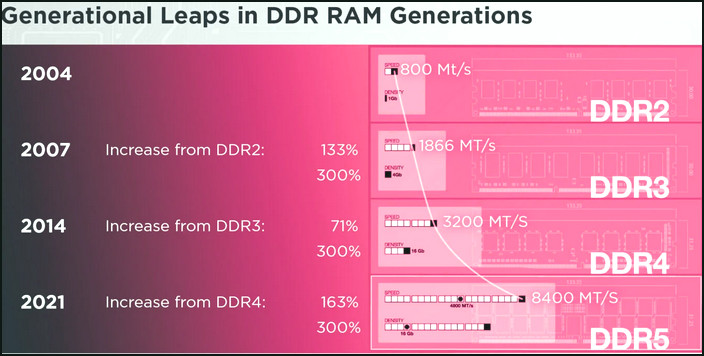
Memory Module Types: Various types of memory modules are available in the market. We can fit all of them into two categories: Single In-Line Memory Module (SIMM) and Dual In-Line Memory Module (DIMM).
While SIMM can only process a single instruction during a clock cycle, DIMM can process two instructions in each cycle.
Memory Timings: Another important thing is the Column Access Strobe (CAS) latency or CL or Timings need to be considered for RAM speed.
CAS latency is the number that tells the total number of cycles or delays time of the RAM to send data to the CPU. It directly affects the overall system performance because your system has to wait for the data to arrive via RAM.
Remember, a lower CL can send and receive data faster; hence it is better. On the other hand, a higher CL is comparatively slower as it takes more time to send and receive data from the CPU.
Everything is getting complicated, right? Let me clarify it for you with a statement.
Let’s judge the above statement with an example.
Consider a RAM that has a 1000 MHz (f) real clock rate, clock period 1ns (T), and CAS latency 10 (CL). The response time of the RAM is T x CL= 1ns x 10= 10s. For this RAM, the adequate response time is 10 seconds.
Contrarily, consider a RAM with a 2000 MHz (f) real lock rate, clock period 0.5ns, and CAS latency 20 (CL). The response time of the RAM is T x CL= 0.5ns x 20= 10s. For this RAM, the effective response rate is also 10 seconds. 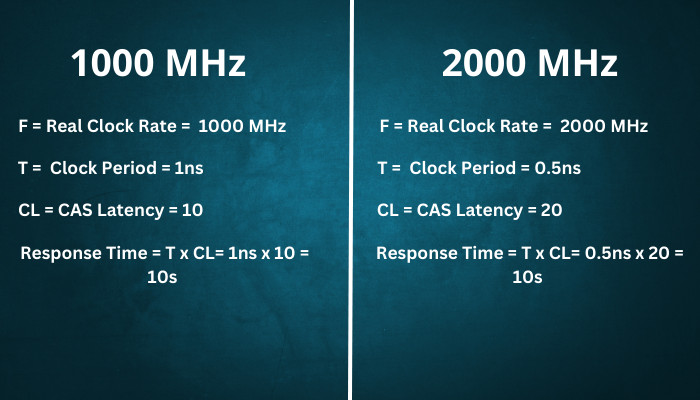
So, how to choose the perfect RAM for your rig?
Depending on the above example, it is clear that you can choose any of the RAMs, and you will still get the same performance.
If you are not interested in doing the math to find the effective response time, check out this sheet, where you will get the adequate response time of every RAM generation and frequency, and then choose the right RAM for your PC.
How does RAM Frequency Affect Overall System Performance?
A computer consists of several parts working together to execute instructions. Each component has a role in overall system performance. As the RAM stores data of currently running tasks, its frequency also affects the overall system performance differently.
Consider the subsequent discussions to understand how memory frequency affects overall computer performance in various circumstances.
Here are some circumstances where memory frequency affects performance:
1. Multitasking
To be frank, increasing the frequency isn’t enough for a noticeable performance improvement in multitasking.
For multitasking, memory capacity is comparatively more influential than memory frequency. However, it doesn’t clarify that memory frequency is unimportant.
The system needs more RAM storage during multitasking than a high frequency because the PC needs more memory capacity to handle the workloads. Running RAMs in dual channels is recommended to avoid any RAM speed-related issues.
For a better multitasking experience, use a higher capacity RAM and focus on the memory frequency.
2. Gaming
RAM speed is vital for gaming and can affect game FPS. Most modern game engines can utilize the higher frequency to boost gaming performance. Some game engines may not be impacted by the frequency at all.
During the benchmarking procedures of recent modern games (check the benchmark in the following section), I noticed a little impact on the average FPS. However, higher memory frequency dramatically improves the 1% and .1% FPS.
Keeping 1% and .1% FPS numbers close to the average FPS ensures a stable gaming experience, even in the most intense moments.
For instance, when playing an action game with multiple players, the CPU and GPU can sometimes hardly provide a stable performance. In such scenarios, extra memory frequency can play a vital role in performance by reducing possible lags.
3. Rendering
For 3D or other heavy-duty renderings, memory frequency plays a vital role. Most of the rendering tasks are CPU and GPU-intensive. However, CPU and RAM work together to make the process more efficient.
If you look closely at the motherboard, you will see the RAM slots are very close to the CPU, even on extra-large motherboards.
It helps the system to transfer data to and from the CPU faster. Memory frequency directly associates the CPU to perform intensive tasks like rendering.
In these scenarios, faster RAM speed makes the CPU faster than the default.
With DDR5 technology, rendering applications like Adobe Premiere are getting a considerable advantage in computing more instructions. However, you may not find high frequency efficient for all applications. Besides, you must also consider the support for high-frequency RAMs.
Do you Really Need Faster Memory Frequency?
The necessity of a higher frequency highly depends on the use cases and your overall system configuration. For most average users, a faster memory frequency won’t add extra value to the system. However, memory-intensive applications will get a boost for faster RAM.
After using multiple RAMs, I have concluded that a RAM with higher frequency and tighter timings can increase the overall FPS in some specific games and applications.
However, this is different from upgrading a GPU because by using a new powerful GPU, you will get a dramatic improvement in most apps and games.
For an average AMD or Intel user, 3200 MHz to 3600 MHz is a sweet spot. AMD DDR4 users can also go for the best 4000 MHz RAMs because of AMD’s high compatibility. For Intel DDR4 users, 3600 MHz is pretty good.
RAM technology is improving so rapidly that nowadays, you will even find RAMs of 7200 MHz frequency. The system’s overall performance is also interconnected with other PC components like CPU, motherboard, etc.
That’s a ton of theoretical discussions, keep them aside, and let me show you some benchmarks to see the real-life importance and performance of faster frequency RAM.
Here is the list of components used during the benchmarks:
- Mobo: ASUS TUF X570 Gaming PLUS WIFI
- Processor: AMD Ryzen 9 3900X
- GPU: EVGA GTX 1080Ti SC Black Edition
- SSD: Samsung 970 Evo Plus 500GB
- RAMs:
- Skill Trident Z RGB 3800MHz (CL16)
- Corsair Vengeance LPX 3200MHz (CL16)
- Corsair Vengeance LPX 3000MHz (CL15)
I ran three different tests for three games using six different speeds and timing combinations. It will help us understand RAM speed’s effect on those games.
Benchmark of Counter-Strike: Global Offensive
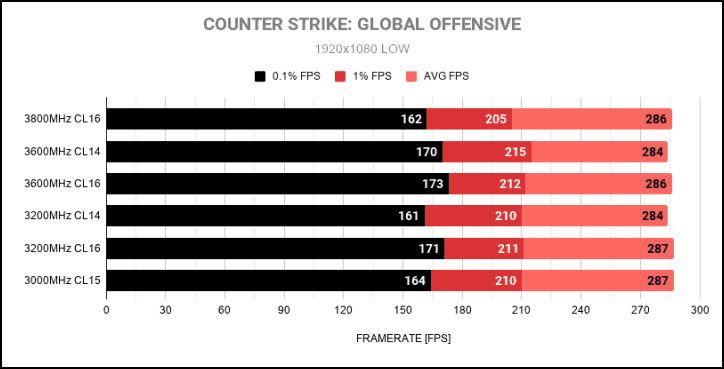
Benchmark of Far Cry 5
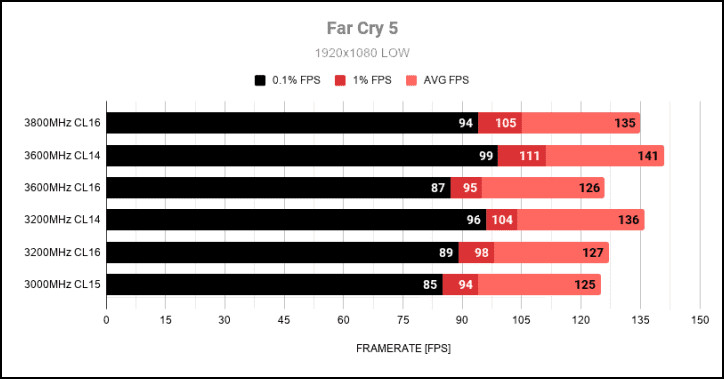
Benchmark of Warhammer II – Total War
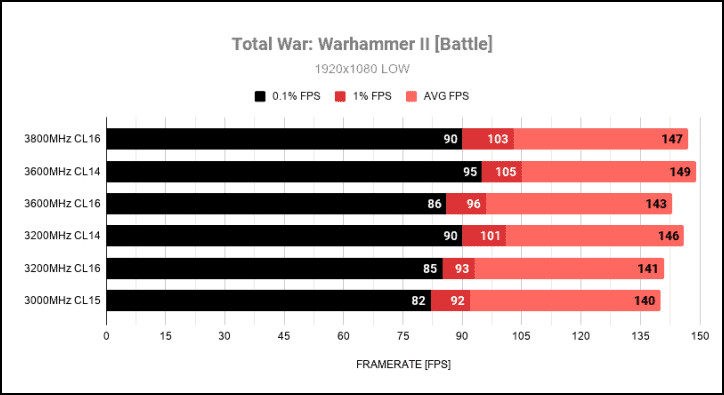
So, what is preferable, more RAM or faster RAM?
The above benchmarks clearly indicate that high-frequency RAM is insufficient for a noticeable performance improvement in most scenarios. Rather than faster RAM, memory capacity (more RAM) is essential for getting a striking improvement in performance.
Can You Mix RAM of Different Speeds?
The direct answer is YES, but you must consider some aspects before installing two RAMs of different speeds. Your system has a supported frequency that it can efficiently handle. While installing two different frequency RAMs, use higher speed RAM than the Mobo specified frequency.
Surprisingly, RAM has no compatibility issues with other RAM of different timings and speeds. Though, a large gap between the RAM speeds can stress your motherboard to run both sticks simultaneously.
However, when you install two RAMs of different speeds, the motherboard is designed to utilize the speed of the less powerful RAM stick, and both RAMs run at the slowest speed.
Let me simplify with an example. It won’t be a big issue if you have two different RAMs with the same base frequency, like 3200 MHz, but different CAS timings, like 16 & 18, because your motherboard will automatically choose the lowest one and runs both at that speed.
Contrarily, if you install two RAMs with different frequencies, like 2400 MHz and 3200 MHz, where the CAS timings are the same, you will notice a considerable performance drop because the motherboard will run both RAMs at 2400 MHz.
The performance will be adjusted depending on the gap between the two RAM speeds.
Increasing the gap between the two RAMs’ frequencies will force the motherboard to run simultaneously harder. Though manually overclocking the RAM may help with the issue, you will likely find a sweet spot for both RAMs to get the best performance.
Consider going through another post on how much RAM you need to choose the best RAM for your gaming rig.
How to Check the Frequency of Your RAM
After going through the above discussions, you already know much about the structure, speed, versions, and how RAM works. But do you know how to check your existing RAM speed quickly? I will show you how to check your memory frequency in two different ways.
Here are the methods to check RAM speed:
1. Use Task Manager
- Press the Ctrl + Shift + Esc buttons to open Task Manager.
- Click the down arrow (More details) to expand the application.
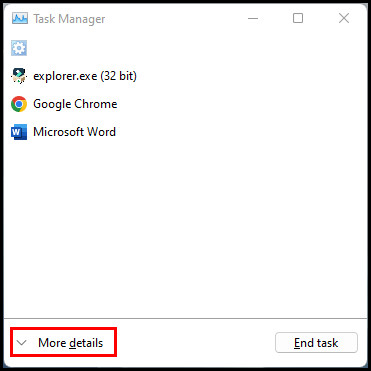
- Switch to the Performance tab.
- Select Memory from the left pane.
- Locate Speed under the Memory composition bar.
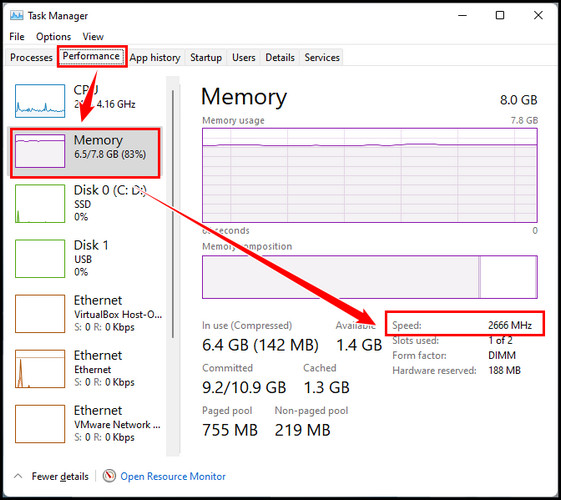
2. Use Command Prompt
- Press the Windows + R keys to open the Run dialog box.
- Type CMD in the text box and hit Enter.
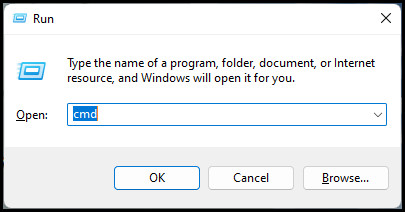
- Paste the following command in the Command Prompt:
- wmic memorychip get speed.
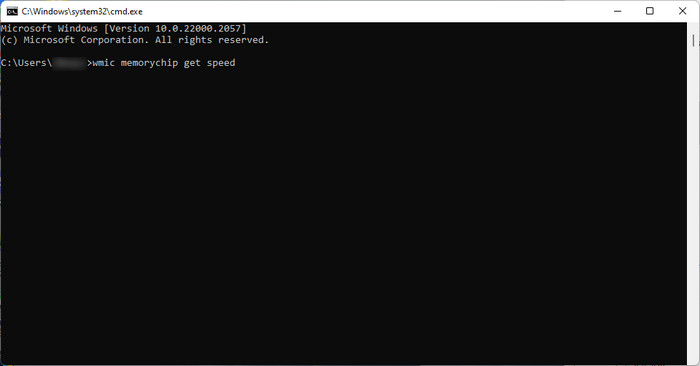
- wmic memorychip get speed.
- Hit Enter to see the memory frequency.
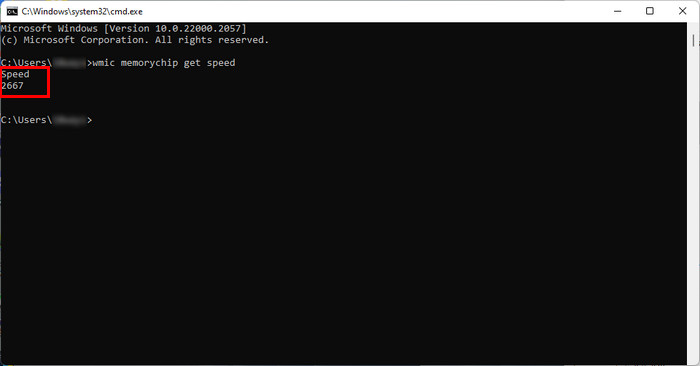
By default, most RAMs run at their base frequency. However, users can overclock the RAM depending on the models to increase the frequency.
There are different ways to overclock RAM: the most efficient method is to use the XMP. Besides, you can also manually overclock if you have expertise.
Frequently Asked Questions
Is higher frequency RAM faster?
A RAM with a higher frequency can complete more cycles per second, ensuring a faster experience. Nonetheless, you must consider other aspects (CPU, SSD/HDD, BUS speed of motherboard) for an overall more immediate experience.
Which frequency is best for RAM?
Choosing the best frequency RAM is critical because the overall performance of your computer also depends on other components (CPU, Storage, Mobo). However, most renowned CPUs (DDR4) can efficiently utilize the power of 3,200 MHz to 3,600 MHz frequency RAMs.
What affects RAM speed?
Several other computer components can affect the speed of your RAM. For instance, the speed of your central processing unit (CPU) and the bus speed of the motherboard can directly affect the overall RAM speed.
Faster RAM is Preferable, But not Vital.
Throughout the article, I have described everything about memory frequency and its role in the system’s performance.
While some demanding applications and games can utilize high-frequency RAM, others don’t need faster RAMs for day-to-day performance. So choose a RAM kit that perfectly blends with other PC components to deliver optimal performance in most scenarios.

